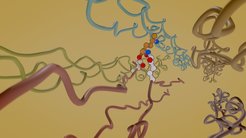Mechanobiology & Mechanochemistry

Proteins exhibit unique and biologically relevant properties once mechanical force acts on them. We aim to decipher the connection between mechanics and function of proteins by molecular simulations at different spatial and temporal resolutions in conjunction with experiments. We have recently discovered that proteins, such as collagen in connective tissue, generate radicals through the breaking of covalent bonds. This discovery unveils mechanoradicals, which had only been found in synthetic polymers, as a previously overlooked source of radicals in biology. Our research aims at explaining key biological phenomena, such as redox-related diseases and aging.
Related questions are how kinases sense mechanical stimuli and transduce them into biochemical signaling cascades, how intrinsic disorder renders protein mechanosensitive, or how and where other biomacromolecules such as DNA or polysaccharides break.
Scientists @ MPIP & collaborators involved
Projects:
- ERC Consolidator grant Radicol
- HSFP with Ronen Zaidel-Bar, Tel Aviv, and Alex Dunn, Stanford
- SFB 1638 on membrane remodelling
